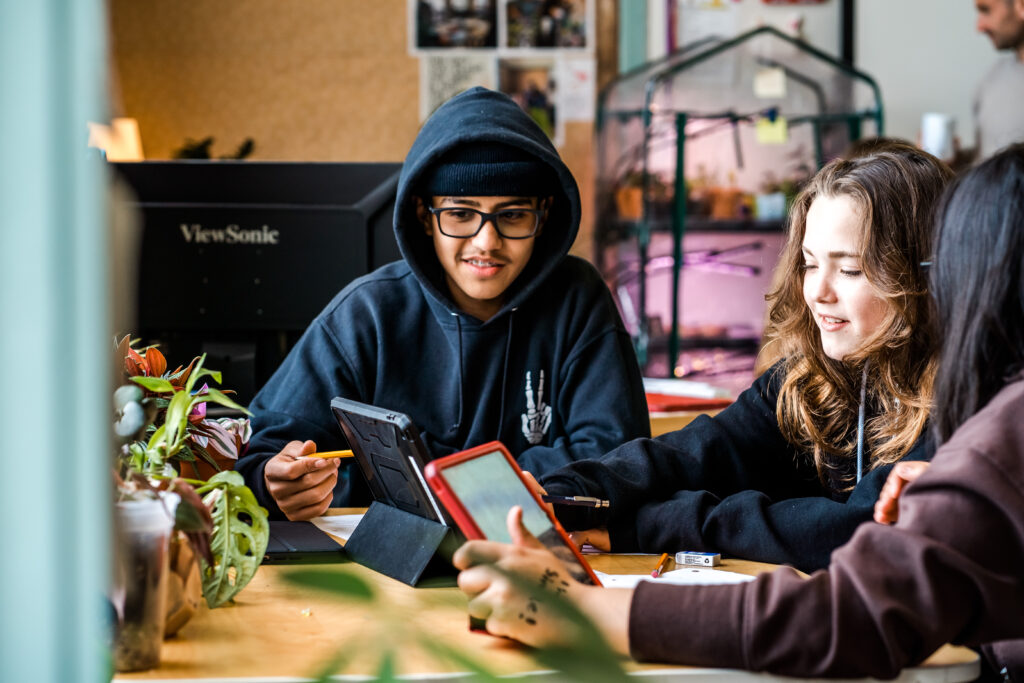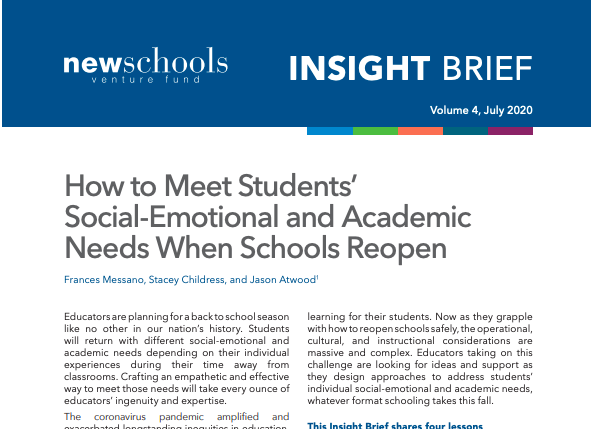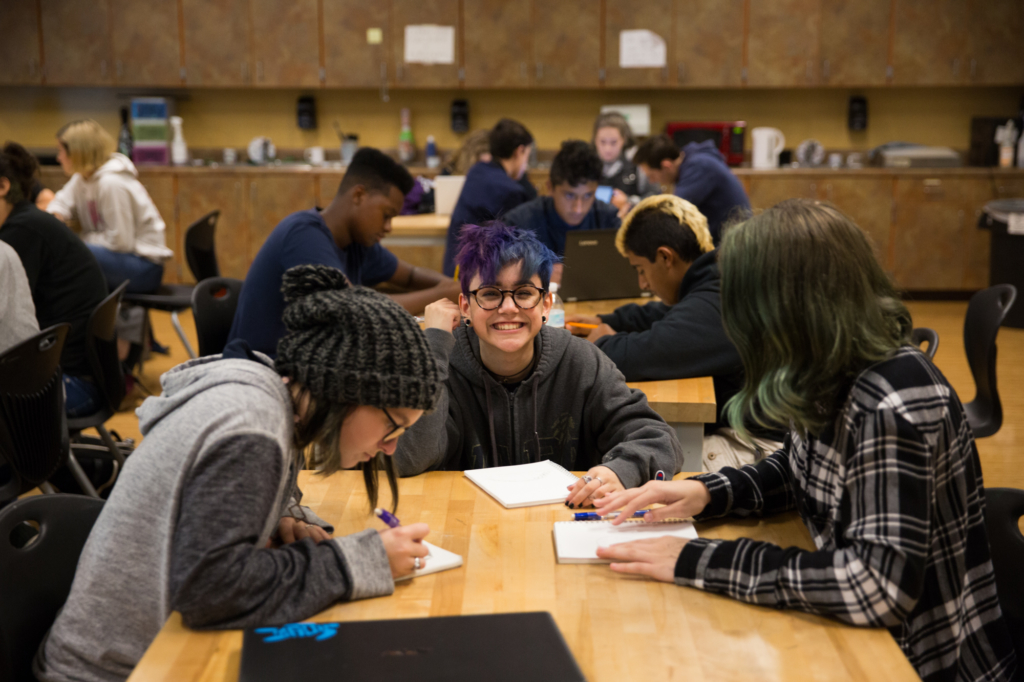By Jason Weeby

Modernizing today’s classrooms with accessible and effective technology in a way that increases student learning and decreases inequities is a critical component of our strategy at NewSchools and a requirement for improving education nationwide. But ed tech is typically a fringe topic in education circles where school governance, accountability, curriculum, and instruction take center stage. When the Covid-19 pandemic swept the globe threatening lives, closing schools, and sheltering us in our places, the 16 million U.S. households with school-aged children suddenly became very interested in the technologies that could engage learners and maintain their academic progress.
The ed tech team at NewSchools is composed of three top industry experts. Like us, they’ve been thrust into the current situation and left to reconcile the grief of a deadly contagious disease with their work and personal lives. Unlike most of us, they have keen insights into the role ed tech is playing right now and what involuntary nationwide distance learning might mean for the future of schooling. I had the chance to sit down with Tonika Cheek Clayton, Justin Wedell, and Cameron White to ask them some questions. Here are their answers.
For parents who have found themselves in the position of teaching their children at home, can you help them set expectations for how technology can and can’t help them?
Cheek Clayton: It’s helpful to remind ourselves that ed tech is not THE solution; it’s something that supports learning. You can’t just sit your child in front of a computer and expect them to learn math. You still need to know what they’re trying, their level of proficiency, and what they need to practice before utilizing a technology tool. When teachers provide you with tools and instruction on how and when to use them, it’s super helpful. When they provide a tool without guidance, it means you have to figure out the rest, which can be frustrating, especially if you must do this for multiple children while balancing work and other family obligations.
Wedell: Right. I feel that a lot of people think about ed tech tools as they might think about an Instapot. You put something in it, push some buttons, leave it alone for a while, and it comes out finished. But ed tech is much more like a kitchen knife, food processor, or — for all those current food hoarders out there — a can opener. It can make the process of cooking more efficient or effective, but you still have to choose the ingredients, prep the vegetables, preheat the oven, add seasoning, and have the awareness to adjust along the way.
White: Parents are coming at this from so many perspectives, and there are so many variables. Something nearly everyone can do is have conversations with their kids about their experiences with distance learning in the same way you’d talk with them about their typical school day. Ask them about what interests them, what’s working, and what’s not. That face-to-face human interaction is still essential, maybe even more essential now that we’re all more isolated physically.
NewSchools, in partnership with Gallup, surveyed thousands of teachers, principals, and administrators about usage in pre-K-12 schools. What did that research reveal that is relevant for this moment?
Cheek Clayton: As our CEO Stacey referenced recently, one thing that was true before the pandemic and is encouraging for distance learning is that 65% of teachers and 57% of students had already said that they used digital learning tools daily. Yet, the fact that 14% of children don’t have access to wifi at home is super relevant now as schools shift to distance learning. Their ability to engage in school work is compromised.
Wedell: When we asked teachers and students how they used ed tech in their classrooms, using it for student collaboration never ranked that high. Knowing that this muscle — using technology to facilitate collaboration — wasn’t exercised much before the pandemic, I wonder what that will mean for the shift to distance learning. Another finding that our analysis revealed was just how fragmented the ed tech market is. When we asked teachers to name the digital learning tools that they were using most often, it surprised us to see just how little overlap there was in what they wrote down. It means that for most teachers, their most commonly used digital learning tools were not the same as other teachers. Parents may encounter this if they have kids in different classes or schools and have to navigate two sets of ed tech tools.
As schools and districts scramble to implement distance learning plans, what should we be looking for in terms of equity?
Cheek Clayton: In an ideal world, people would have their basic needs met during a crisis so that they can focus on learning. Assuming they do, students should have access to devices and wifi so they can engage effectively with teachers and peers to continue learning. As districts shift to distance learning, they can use the moment as a testing ground for how to support ongoing education at home as a foundation for better and more equitable outcomes even after students return to school buildings.
White: I always come back to the equity conversation through the lenses of access, use, and outcomes. On the access front, districts are reaching out to identify families who don’t have devices and loaning them devices. We’ve also seen creative solutions for providing wifi in communities. Even with devices and wifi, there are still access issues when multiple people in a household are sharing devices or a data plan. On usage, parents are taking a much more significant role in how education is delivered. Technologies designed for trained teachers in a classroom don’t always translate well to use at home. Equitable academic outcomes are a priority for us, but in the short term, we have to think about it in terms of students being safe, healthy, fed, and sheltered. The possibility of widening equity gaps is real, and we must be ready to address it.
Wedell: Education in the United States wasn’t equitable to begin with and it’s not going to be equitable now. If anything, this crisis is further revealing the deep and painful inequities upon which our society is built, and education is no exception. But equity can come from what we learn from this moment. Looking ahead, I’m optimistic that this might spur more significant policy change for how we serve all of our nation’s students. I’m hopeful that not only policymakers at all levels, but also we as community members will look at the inequities that this crisis has laid bare and commit to making a change. If this crisis isn’t enough to spur such action, I don’t know what is.
Is this moment challenging any of your fundamental beliefs about ed tech?
Cheek Clayton: The focus of our work to date has been on ensuring that students’ learning experiences in classrooms would lead to equitable outcomes. We focused less on home ed tech because there’s so much variability in access to devices and wifi across homes within underserved communities. Now that I’m seeing some positive signs of communities working together to provide an infrastructure for all students to access devices and wifi from home freely, I’m thinking about the home learning environment differently. How can ed tech work in both school and home contexts involving teachers and parents as educators? The answer could reshape how teachers and parents connect around their students’ learning and have a real positive impact on education in the future. Many products already focus on in-home learning, but many require subscription fees, which favors families who can afford them. So current and new products adapting to home-based education need to ensure equitable access and participation.
Wedell: From the perspective of an ed tech funder, this moment is making me reflect upon the imperative for us to think more collectively in terms of our impact. Ed tech funders, developers, and implementers often operate in a silo ignoring the critical interdependencies that our success relies on like health, safety, food security, and strong community relationships. If we widen our aperture as funders, we can change our perspectives on ed tech as a workaround for other systemic issues and perhaps be more accountable to how it might complement or amplify the efforts of those working on different critical community needs.
White: There’s always been the idea that there needs to be a certain level of customizability in the implementation of ed tech products. What the shift to distance learning has illuminated for me is just how critical considerations of the learning environment are when every home is different. Every school and district is handling this crisis differently. Product developers have to think about how to balance building for a specific instructional context with enabling flexible use in the face of uncertainty.
When the pandemic subsides, do you think American pre-K-12 education will be different? If so, how?
Cheek Clayton: Yes, I do think it’ll be different. I think a lot of things will be different. We were all blindsided by the pandemic and mass school closures. They forced schools and districts to create and implement distance learning plans very quickly. We don’t know if this will subside or be an ongoing health crisis, but I assume districts will take their distance learning plans much more seriously. As a result, schools and districts will purchase ed tech tools partly on their ability to work in the classroom and at home.
Wedell: For so long, school life and home life have been siloed. Distance learning will help bring them closer together. Unfortunately, what probably won’t change in the long run is respect for the average public school teacher. As a former teacher, I worry that people are going to be real quick to forget about the lessons from this experience of just how complicated and nuanced effective teaching really is. This is a big concern for me, and I hope I’m proved wrong.
Cheek Clayton: That’s where we disagree. Speaking from experience, the struggle to teach one’s children is real. For those of us who don’t consider ourselves good teachers, we’ll appreciate teachers even more when schools are open again.



